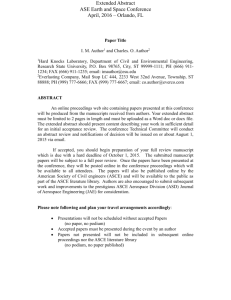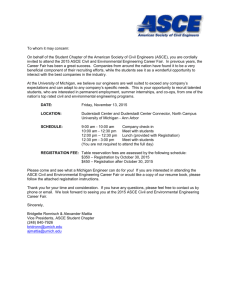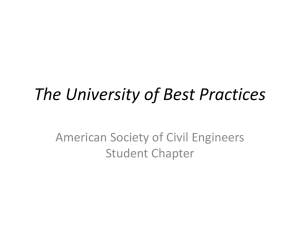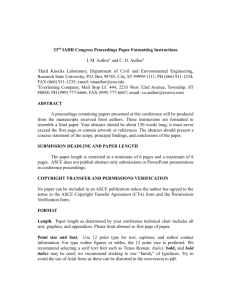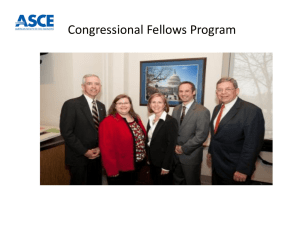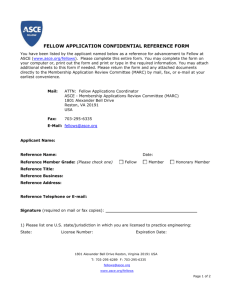Read the project summary
advertisement
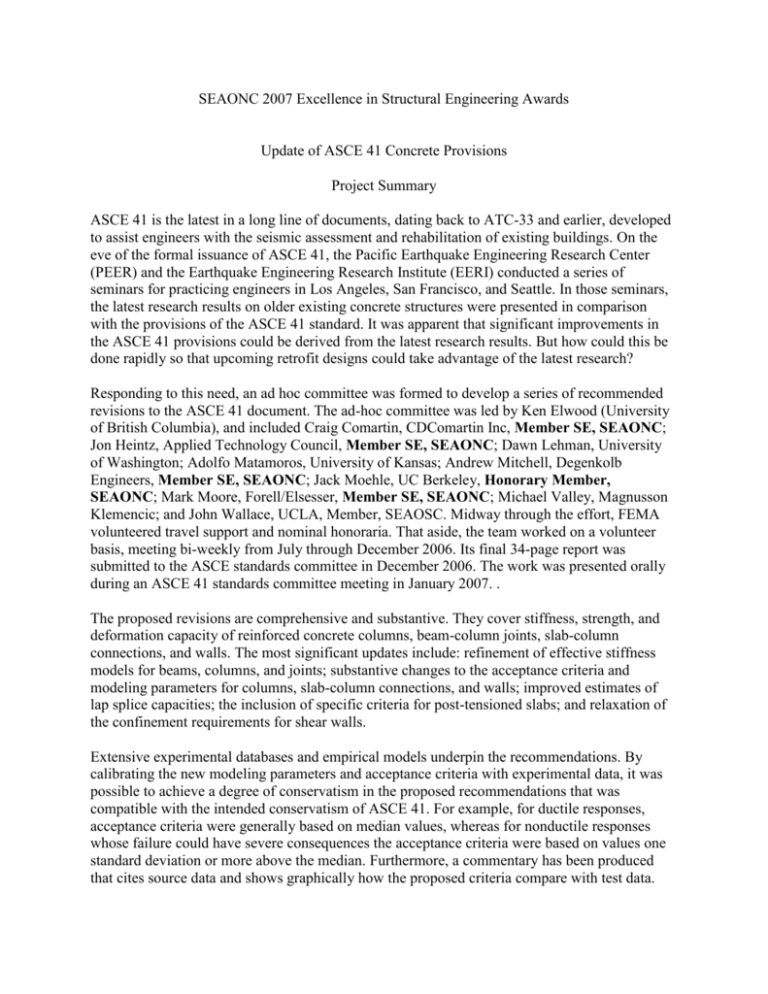
SEAONC 2007 Excellence in Structural Engineering Awards Update of ASCE 41 Concrete Provisions Project Summary ASCE 41 is the latest in a long line of documents, dating back to ATC-33 and earlier, developed to assist engineers with the seismic assessment and rehabilitation of existing buildings. On the eve of the formal issuance of ASCE 41, the Pacific Earthquake Engineering Research Center (PEER) and the Earthquake Engineering Research Institute (EERI) conducted a series of seminars for practicing engineers in Los Angeles, San Francisco, and Seattle. In those seminars, the latest research results on older existing concrete structures were presented in comparison with the provisions of the ASCE 41 standard. It was apparent that significant improvements in the ASCE 41 provisions could be derived from the latest research results. But how could this be done rapidly so that upcoming retrofit designs could take advantage of the latest research? Responding to this need, an ad hoc committee was formed to develop a series of recommended revisions to the ASCE 41 document. The ad-hoc committee was led by Ken Elwood (University of British Columbia), and included Craig Comartin, CDComartin Inc, Member SE, SEAONC; Jon Heintz, Applied Technology Council, Member SE, SEAONC; Dawn Lehman, University of Washington; Adolfo Matamoros, University of Kansas; Andrew Mitchell, Degenkolb Engineers, Member SE, SEAONC; Jack Moehle, UC Berkeley, Honorary Member, SEAONC; Mark Moore, Forell/Elsesser, Member SE, SEAONC; Michael Valley, Magnusson Klemencic; and John Wallace, UCLA, Member, SEAOSC. Midway through the effort, FEMA volunteered travel support and nominal honoraria. That aside, the team worked on a volunteer basis, meeting bi-weekly from July through December 2006. Its final 34-page report was submitted to the ASCE standards committee in December 2006. The work was presented orally during an ASCE 41 standards committee meeting in January 2007. . The proposed revisions are comprehensive and substantive. They cover stiffness, strength, and deformation capacity of reinforced concrete columns, beam-column joints, slab-column connections, and walls. The most significant updates include: refinement of effective stiffness models for beams, columns, and joints; substantive changes to the acceptance criteria and modeling parameters for columns, slab-column connections, and walls; improved estimates of lap splice capacities; the inclusion of specific criteria for post-tensioned slabs; and relaxation of the confinement requirements for shear walls. Extensive experimental databases and empirical models underpin the recommendations. By calibrating the new modeling parameters and acceptance criteria with experimental data, it was possible to achieve a degree of conservatism in the proposed recommendations that was compatible with the intended conservatism of ASCE 41. For example, for ductile responses, acceptance criteria were generally based on median values, whereas for nonductile responses whose failure could have severe consequences the acceptance criteria were based on values one standard deviation or more above the median. Furthermore, a commentary has been produced that cites source data and shows graphically how the proposed criteria compare with test data. This information can be especially useful for an engineer who must make a retrofit decision considering components that are in a borderline condition. Most of the modifications to the concrete provisions liberalize the acceptance criteria, allowing the engineer to develop more cost-effective retrofit solutions while still providing confidence in achieving the specified performance objective. For example: for secondary shear-critical columns with low axial loads, ASCE 41 would only allow a plastic rotation of 0.004 radians at CP, while the proposed provisions allow plastic rotations ranging from 0.006 to 0.06 radians depending on the transverse reinforcement ratio; for lap splices typical of older concrete buildings the proposed criteria allow a steel stress that is approximately 45% higher than that allowed in ASCE 41; for slab-column connections with continuity steel, the proposed provisions increase the allowable drift ratios by up to 0.02 radians depending on the gravity shear ratio; for shear-controlled walls with low axial load, the proposed provisions increase the CP allowable drift by 33%. Where demonstrated by experimental evidence, some acceptance criteria and modeling parameters were tightened. In particular, for columns with high axial loads and very light transverse reinforcement, full-scale laboratory tests suggest that axial failure can occur rapidly after shear failure, and hence, the proposed provisions do not allow any plastic rotations, regardless of the performance level. The proposed revisions were completed in December 2006 and delivered at that time to the ASCE 41 Standards Committee. In a ballot closing 22 March 2007, all proposed changes passed by large margins. We look forward to the issuance of a supplement to ASCE 41 that will formalize the use of these new criteria. Their use will result in more effective retrofits of concrete buildings and will in most cases result in significant reductions in retrofit costs. The active participation of SEAONC members, with broad experience in seismic retrofitting practice, brought focus to the document. That, and their expert knowledge of the technical issues at hand, demonstrated the high level of structural engineering practice in Northern California. Thus, the magnitude of this endeavor and the quality of the final product are a credit to SEAONC and to the dedication of our profession to creating a safe and functional built environment.
